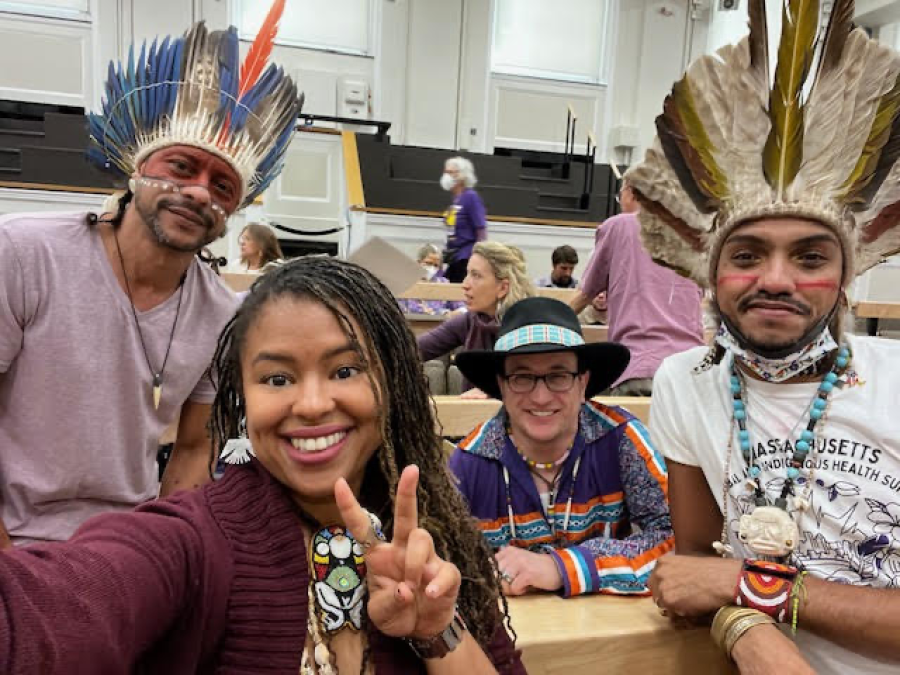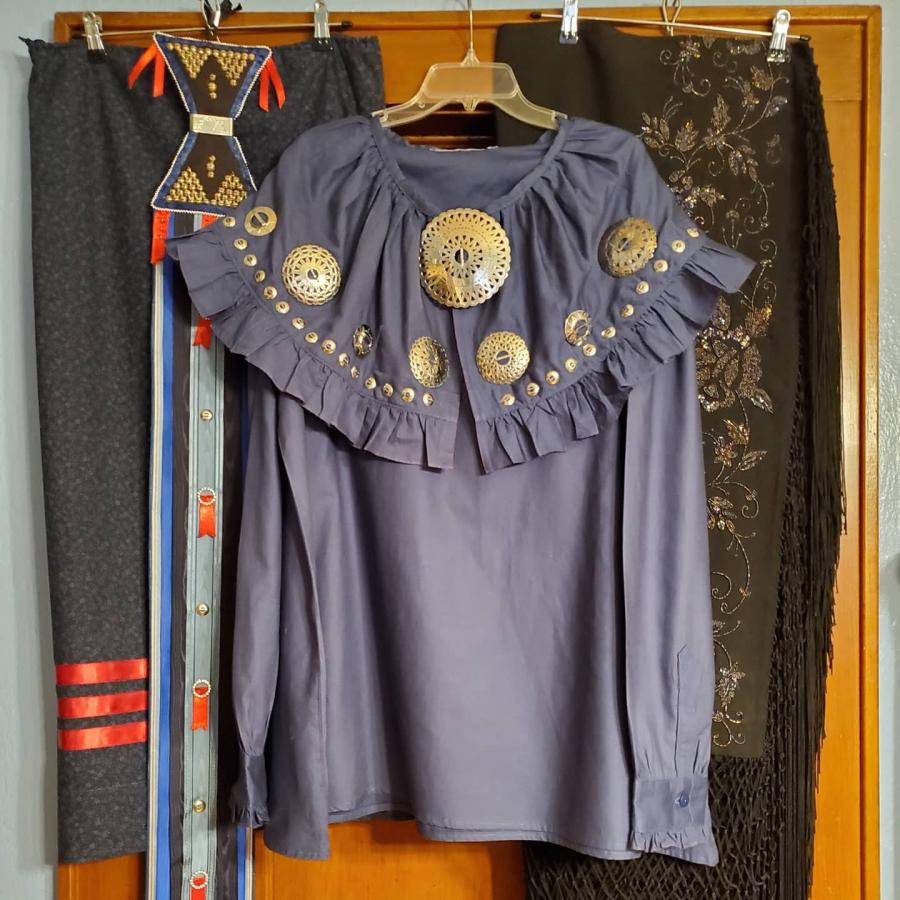“You are either at the table, or you are on the menu," a Wisconsin utility executive advised Rosebud Tribal Utility Commission Attorney Robert Gough. Few tribes would argue: whether you consider federal appropriations (or lack thereof), or the issues surrounding energy development and tribes, today's pitched battles over rising federal deficit, an energy policy looking toward either the Arctic National Wildlife Refuge (ANWR) oil or new coal from the sacred Zuni Salt Lake area, or nuclear waste dump proposals in Western Shoshone territory, it is clear that throughout most of history tribes have not been allowed to the table.
These days, however, they are seating themselves—particularly the Northern Great Plains tribes who are members of the Intertribal Council on Utility Policy (Intertribal COUP). Those tribes have tackled some of the hardest energy policy issues in Indian country, including production, distribution, and pricing, and have come up with a brilliant plan for the future: wind energy, with plenty of benefits to go around.
"We believe the wind is wakan, a holy or great power. Our grandmothers and grandfathers have always talked about it, and we recognize that," explains Pat Spears, a Lower Brule Tribal member who is the president of Intertribal COUP. Spears and Gough have worked with a number of tribes in the Great Plains, and were looking forward to April 10 on the Rosebud Reservation, when the first tribally owned wind generator (750 kilowatts) was dedicated. That turbine is a model project, and Intertribal COUP hopes it will "set the stage" for a broad wind-generating plan for the tribes in the Great Plains region, bringing at least 3,000 megawatts of power to market in the next decade. This ambitious goal is but a fraction of the over 300 gigawatts of wind power potentially found on the Great Plains Indian reservations, or more than half of all present U.S.-installed electrical capacity.
Talking to some of the largest casino tribes in the country at the United Southern and Eastern Tribes meeting in Washington, D.C., in early February, Gough laid out the potential for tribal investment, income, and environmental protection through new partnerships: "We don't just want to be there when the blue-haired ladies put quarters into the machines. We want to be there any time a light switch goes on."
Buying In
Anyone can get the generators up and running and buy into their benefits. Presently, wind energy is the fastest-growing energy source in the country—and, in fact, the world. New plans are sprouting up everywhere, and by and large they consist of utilities buying wind rights from landholders who have windy lands, who in turn give those individuals a percentage of the royalties—say a two-to-three percent royalty—the rest of the profit goes to the utility. Because the only real costs for wind turbines are the installation and some maintenance—you don't have to pay for fuel—the profit margin can be pretty high. That's what Intertribal COUP wants to keep in Indian country.
People can take advantage of the wind energy program in several ways. Those who have the bucks can invest. Or consumers can buy green tags and get either a tax write-off or a business expense credit for buying premium green electricity. A partnership between Intertribal COUP, Honor the Earth (a national Native foundation), and Native Energy makes this green tag plan happen. Native Energy puts all the green tag purchases together to help pay for the up-front costs of putting up a wind generator. Then, with a nonprofit called Clean Air Cool Planet, the group retires those green tags permanently so they are off the market—and clean energy is in. So, local consumers can use "carbon neutral" energy (even in all those cars and buses that go to the casinos). They are directly responsible for supporting tribally based clean energy generation and thereby reducing the overall electrical system's contribution to global climate change (lignite coal-fired power plants release more carbon dioxide gases than any other source in the country). And the wind generators get put on the reservations that have some of the most cost-efficient wind power in the world.
Why should this all matter to anyone? Well, if global climate change doesn't concern you, it probably should. "Over a period of just 200 years, we have caused the amount of the main heat-trapping gas in the atmosphere to grow by almost a third, to a level not likely to have been exceeded for 20 million years," explains the Climate Initiative Fund. In other words, we humble human beings have done more than any other critters in the history of the world to make the global climate change. Some of the changes we have made include: Arctic ice in the summer has decreased by 40 percent; sea levels have risen by two-tenths of a meter; snow cover has decreased by l0 percent; 4.2 million acres of forest in Alaska have died or is dying because, with a longer warm season, the spruce beetles that harm forests reproduce twice as fast; and vector-borne diseases (such as the West Nile virus) are on the increase. Each year the record number of disasters attributed to climate change increases dramatically.
Wind Sheds
"We have learned with watersheds, that you don't pollute upstream from where you get your drinking water." Such is the idea of the "windshed," a term coined by Intertribal COUP to talk about why anyone east of the Great Plains might like to see a bit more wind and a bit less coal burned. For Great Plains tribes, a clean energy WindSHED means "sustainable homeland economic development" (SHED) built upon wind energy. For people living downwind, it means breathing a little easier and being able to eat the fish and enjoy healthy forests.
Already, on the White Earth reservation, like on many other Ojibwe reservations, advisories suggest that residents limit their fish consumption. That's a huge problem for fishing cultures. Turns out that a good portion of what is in the fish comes from coal-fired power plants and incinerators upwind. "They are burning dirt," Spears explained as he talked about the North Dakota lignite that is burned in the coal-fired power plants in the Dakotas. "That is pretty much the dirtiest coal in the country," and that is what ends up in the Anishinaabeg lakes. "With regard to building new power plants, the Great Plains can either give you coal or we can give you wind power," Gough explained. The choices are up to us.
Intertribal COUP has some big plans in the face of some challenging issues. For instance, the United States is the only country that has not signed the Kyoto Protocol addressing the issues of global climate change. And, with about four percent of the world's population, Americans produce around 25 percent of the world's greenhouse gases. In the face of this global challenge, the George W. Bush administration has called for "voluntary" emissions reductions. "Some tribal leaders feel they should go to Washington and say, 'We volunteer,' just as Indian people have always done for this country more than any other group of Americans, especially in times of war and crisis," Gough suggests. "Renewable energy production, along with energy efficiency, could entirely enable the U.S. to reach the carbon reduction levels expected in the Kyoto accords. Tribal renewable energy development could just come to the service of America, like the Navajo and Lakota code talkers of World War II, and all of those other times that Native people volunteered for service to the U.S. And, just to give perspective on the vast tribal renewable energy resources in this country, the wind power potential on just the Rosebud and Pine Ridge reservations alone could meet the Kyoto targets for all of North America."
Tribal wind power needs some help in new federal energy bills. Tribes need to have access to the same financing mechanisms and incentives available to private developers and municipalities. Tribes need to have access to put wind power on the federal grid system built to provide hydropower to most of the western United States.
With the extended drought, our water resources are diminishing. Tribal wind power could make up for the lost hydropower cheaply, quickly, and cleanly. Tribes also need to have access to the federal green power market. By 2005, the U.S. federal government is scheduled to make two and a half percent of its total energy consumption "green," and the Great Plains tribes could provide the renewable power to green the federal government through sales of wind power to the Western Area Power Administration. Besides that, the Intertribal COUP plan for homegrown energy generation has an important homeland security aspect to it. As Bob Gough aptly points out, when compared to the many vulnerable nuclear power plants located in the more densely populated parts of America, "no one's looking to run an airplane into a wind turbine."
Winona LaDuke is founding director of the White Earth Land Recovery Project in Minnesota and program director of the Honor the Earth Fund.



